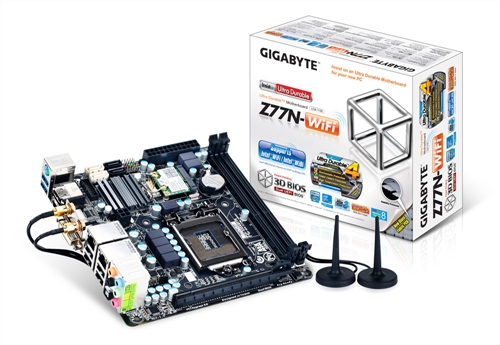Konklusion

Bundkortet her har jeg en smule svært ved at placere. Det har fået Intel's Z77 chipset, men ingen mulighed for at ændre spænding til andet end RAM. Bundkortet har fået 4+1 faser, hvilket gør at der nok ikke er meget i overskud, men 1.3 volt ville jeg gerne have set, og det burde kortet også kunne klare.
Jeg har desuden set flere på nettet klage over at det ikke er muligt at give sin CPU underspænding. Ofte så er stockspænding faktisk mere end hvad der er nødvendigt, og der kan spares en del strøm hvis man giver CPU'en mindre spænding end standard.
Vi så også her at standardspænding faktisk var nok til 4.3 Ghz, så mon ikke vores 3770K CPU ville kunne klare lidt underspænding ved standard hastighed, men det får du altså ikke lov til her.
Jeg ved, at der er nogen der arbejder på et hard mod så spændingen til CPU'en kan styres med modstande, men så ryger garatien, og det er også ganske få der gider sidde med loddekolbe og lodde modstande på sit bundkort.
Gigabyte kunne have valgt at gøre sådan, at BIOS kun ville sætte spændingen til maksimum 1.3 volt, men man har åbenbart valgt at fjerne den helt, på et Z77 bundkort.
Intel WiDi siger mig ikke helt så meget på bundkortet her. Jeg kan helt klart se fordelen ved at have WiDi på en bærbar computer, men på en stationær giver det ikke meget mening. Systemet skal startes op med en skærm tilsluttet alligevel. Man kan dog diskutere om det er smart at kunne sende skærmbilledet fra kælderen op i stuen, men de inputsystemer vi har i dag kan ikke nå lige så langt som WiFi kan, hvilket betyder at du skal styre i blinde på WiDi skærmen.
Innovation/Teknologi - 3
Bundkortet har ikke noget nyt og revolutionerende, og det er sikkert på grund af sin størrelse. Bundkortet er fyldt godt op, og det har sikkert ikke været muligt for Gigabyte at smide flere funktioner på det.
Bundle/Tilbehør - 3
Du får det med du skal bruge, og så heller ikke mere. For en bundle der passer til bundkortet giver jeg 3.
Design/Layout - 4
Det er rigtig svært at få pakket mange ting ned på et så lille bundkort, og her synes jeg Gigabyte gør det rigtig godt. Jeg ville dog gerne have set et par faser mere og måske en lille køler til disse, så vi kunne få lov til at ændre spændingen, så vi også kan udnytte det Z77 chipset lidt mere.
Software/BIOS - 4
BIOS'en har ikke ændret sig siden jeg sidst kiggede på et Gigabyte bundkort, udover at det kun er muligt at ændre spændingen på RAM. Softwaren har Gigabyte heller ikke ændret på, EasyTune 6 er et program jeg rigtig godt kan lide fordi det er så simpelt.
Ydelse - 4
Det bliver ikke helt til et 5 tal her, men bundkortet klare sig rigtig godt, især fordi det er så lille. CPU ydelsen er der intet at klage over, dog har kortet det en smule svært når det kommer til 3D, men bestemt stadig fin ydelse til et mITX bundkort.
Pris - 3
Endnu engang har jeg svært ved at finde det store "selling point" for dette bundkort. Det er åbenlyst, at selvom chipsettet er Z77, så var der ikke tænkt overclock med dette bundkort. Det er sikkert WiDi understøttelse der skal sælge kortet her, men det kommer altså med den pris, at spændingen ikke kan ændres på andet end RAM. Det er dog det billigste Z77 mITX bundkort jeg har kunnet finde, men Z77 chipsettet kan ikke helt bruges her alligevel. Jeg vil dog mene H77N-WiFi der koster 860kr. og har præcis sammen funktioner vil være et bedre køb hvis det er WiDi man leder efter.
Efter jeg blev færdig med denne test har Gigabyte svaret på hvorfor man har valgt ikke at kunne ændre spændingen til andet end RAM. Gigabyte valgte ikke at medtage spændingsændringer på andet end RAM fordi kortet er så lille og strømstyringen ikke vil kunne klare ret meget. Bundkortet er heller ikke henvendt til overclock og Gigabyte mener at man alligevel ikke vil hæve spændingen på sin lille HTPC, hvilket nok også er korrekt. Bundkortet er designet således at der fysisk skal laves ændringer for at kunne ændre spænding overhovedet. En maks. og min. spænding bliver sat med software, altså BIOS'en, men bundkortets design tillader desværre slet ikke ændring af volt. De besluttede sig derfor for at holde prisen på bundkortet nede at bruge billigere komponenter der ikke tillader ændring af spændingen.
UK summary

I find it a bit difficult to classify this motherboard. It is equipped with Intel's Z77 chipset, but without possibilities to change the voltage except for the RAM voltage. The board has 4+1 phases, which means that there is probably only little reserve, but I would have liked to see 1.3 volt which the board should be able to cope with.
In addition, I have seen several complaints on the net that it is not possible to reduce the CPU voltage. The stock voltage is often more than what is necessary, and you can save quite some energy by setting the CPU voltage below the factory setting.
We saw that the default voltage was sufficient to run at 4.3 GHz, so our 3770K CPU would probably run with default speed, even with reduced voltage – but this we are not allowed to try out here.
I know that some people are working with a hard mod in order to control the CPU voltage with resistors, but this will leave you without guarantee. And besides, there are probably only few people who are willing to sit with their soldering iron and add resistors to their motherboard.
Gigabyte could have chosen to allow BIOS to set an upper CPU voltage limit to 1.3 volt, but they have apparently chosen to remove any voltage adjustment completely on a Z77 motherboard.
Intel WiDi is of little importance to me on this board. There is an obvious advantage in having WiDi on a notebook computer, but on a desktop it does not make much sense. The system must be started up with a traditional screen anyway. You can of course argue whether or not it is smart to be able to send the screen up from the basement to the ground floor. But the input systems we have available today does not have the range that WiFi has, so you will have to work blindfolded on the WiDi screen
Innovation/Technology - 3
This motherboard does not offer anything new or revolutionary, and this is probably due to its size. The card is closely packed, and most probably it has been impossible for Gigabyte to add more features.
Bundle/Accessories - 3
You get what you need and nothing more. A bundle suitable to the motherboard triggers 3 points.
Design/Layout - 4
It is really hard work to pack that much functionality on such a small motherboard, and I find that Gigabyte has done a fine job here. One thing I would have liked to see is a couple of additional phases, perhaps equipped with a small cooler, so that we would have had the opportunity to change the voltage and get a bit more performance from the Z77 chipset.
Software/BIOS - 4
The BIOS has not changed since the previous time I looked at a Gigabyte motherboard, except from the fact that it is only possible to change the RAM voltage. Also, Gigabyte has made no change to the software. EasyTune 6 is a program that I appreciate due to its simplicity.
Performance - 4
Once again, we cannot go all the way to 5 points, but the motherboard is doing quite well, especially considering its small size. There is nothing to complain about regarding the CPU performance. The only reservation is that the board is struggling a bit when it comes to 3D, but it is absolutely a find performance for a mITX motherboard.
Price - 3
Once again, I find it hard to see the big "selling point" for this motherboard. It is obvious that although the chipset is Z77, the card has not been designed for overclocking. It is probably the WiDi support that is supposed to sell this card, but you have to renounce from voltage regulation on anything but the RAM. It it the cheapest mITX motherboard I have been able to find, however, but the Z77 chipset cannot be fully utilized. In my opinion, H77N-WiFi, which is priced at 860 DKK and have exactly the same functions, will be a better buy if WiDi is what you are looking for.
After completing this test, Gigabyte has answered me why they have chosen not to allow the user to change the voltage on anything but the RAM. Gigabyte decided to exclude voltage regulation on anything but RAM because the board is so small and the power management would be unable to support it. The motherboard is not aimed at overclockers and Gigabyte does not find it relevant to increase the voltage on a HTPC that small, which probably is a valid point of view. The boards design physically does not allow changing the voltage at all. Normally a max. and min. volume for the voltage is set by software (the BIOS) but this boards design simply do not allow the change at all. They therefor decided, to get the price down because you probably won't overclock anyway, to use cheaper components that does not allow the voltage changing.
Test: Gigabyte Z77N-WiFi
| Innovation / Teknologi | 3 |
| Bundle - Tilbehør | 3 |
| Design - Layout | 4 |
| Software - BIOS | 4 |
| Ydelse | 4 |
| Pris | 3 |
| |
| Samlet | 70% |
Læs om vores forklaring på ratingen
herRead about our ratings
here






